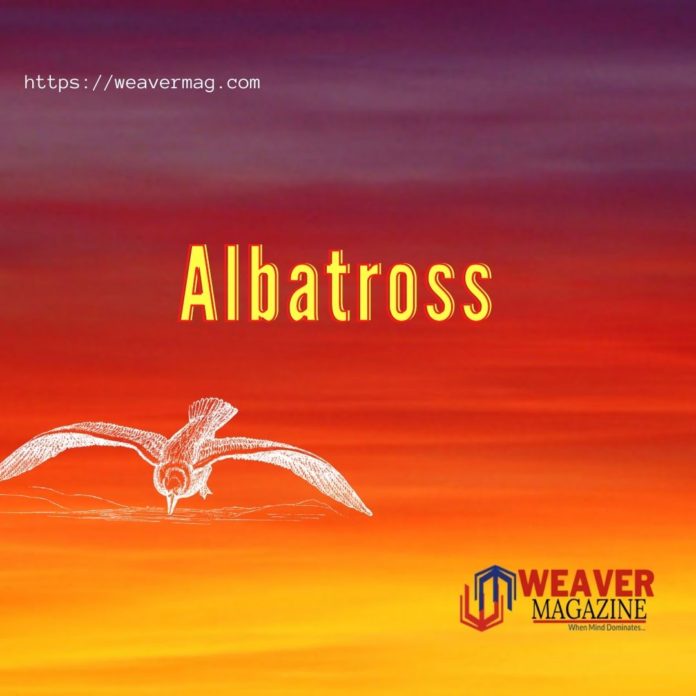“At length did cross an Albatross,
Through the fog it came:
As if it had been a Christian soul,
We hailed it in God’s name”
Are you familiar with these popular lines of Coleridge’s ‘Rime of the Ancient Mariner’? The beautiful lyrical ballad recounts the unpleasant experiences of a sailor who has returned from a long sea voyage. Albatrosses are portrayed as “the most legendary of all birds”. It is the central emblem in the poem, representing the innocence and beauty of God’s creation.
Albatrosses represent the largest of flying birds. They are species of family Diomedeidae, have the longest wingspans of any extant birds, reaching up to 3.7 m and are the largest of all procellariformes. The birds have large, strong, and sharp edged bill. The plumage of an albatross is usually some distinction of black upper-wings and back with light undersides. They travel huge distances over the sea by applying unique methods of flight. One is called dynamic soaring, where the bird needs repeatedly rise into wind and descend downwind. Slope soaring is the other technique which uses the rising air on the windward side of large waves. A bewildering fact about dynamic soaring of Albatrosses is that it inspires airplane designers. Johannes Traughott and colleagues who have charted the albatross’s nuanced flight pattern and are looking for ways to apply this to aircraft. True, nature is indeed the best teacher.
Etymology:
The etymology of the name of the bird is as interesting as the bird itself. The word ‘Albatross’ is derived from an Arabic word al-qadus meaning ‘the driver’, which travelled to English via its Portuguese form Alcatraz. It might have been influenced by Latin albus, meaning ‘white’. In Portuguese, the word used for bird, albatroz, is in turn derived from the English albatross.
“And a good south wind sprung up behind,
The albatross did follow,
And every day for food or play,
Came to the Mariner’s hollow”
Despite initial good fortune, the ship in Coleridge’s poem is driven south by a storm. It eventually reaches the icy waters of the Antarctic. The lucky bird appears and leads the ship out of the ice jam where it is stuck. Let’s see the habits and distribution of the bird.
Distribution:
The beautiful birds mostly range in the Southern hemisphere from Antarctica to Australia, South America and South Africa. So, if you ever go for a voyage in the peaceful Pacific, look out for this creature.
They usually feed on fishes and small sea animals like squid, krill by scavenging, surface sneezing or diving and drink sea water.
They are colonial, nesting for the most part on remote islands. And the fact that several species are often found nesting together is quite fascinating. Isn’t it?
One can not see them in the North Atlantic now, although fossil remains show they once occurred there and occasional vagrants are found. But what caused their extinction is still unknown. Well, in addition to being the largest sea bird, the albatross holds another title as well. The Laysan albatross , named Wisdom, on midway island is recognized as the oldest wild bird in the world. She was banded in 1956 by Chandler Robbins.
Wide variety:
Current division has assigned the albatrosses, four genera but the number of species is still a debate. Among the great albatrosses are the wandering albatross which has a circumpolar range in Southern ocean. It is also known to have the longest wingspan of any living bird. The Amsterdam albatross which breeds only on Amsterdam island in the Southern Indian Ocean and the Northern royal albatross also belong to this genera.
The North Pacific albatrosses have been alloted a separate genera as they have species like waved albatross also known as the Galapagos Albatross. It shows a straight path to a single site off the coast of Peru every time they forage. The black footed albatross is special for being different from other albatrosses by being dark plumaged.
Mollymawks is another genera of containing Black browed albatross called so because of their dark grey saddle and upper wings. The shy albatross that breeds on three remote islands off the coast of Tasmania, Australia, and so its queer name and Indian-yellow nosed albatross which do need much further description are also Mollymawks.
The light mantled albatross is largely sooty-brown and its plumage has been described as being similar in appearance to the colouring of a Siamese cat. It is considered under the genera Sooty albatross which also contains a species of the same name.
“’God save thee mariner!
From the fiends, that plague thee thus!—
Why look’st thou so?’ – With my cross-bow
I shot the ALBATROSS.”
After the albatross lead the ship out of grave danger, it was praised and fed by the crew, but later the mariner shoots the bird. It arouses the wrath of the heavenly spirits who then pursue the ship ‘from the land of mist and snow’. The same wind that had initially blown them north now sends the ship into unexplored waters near the equator, where it is becalmed.
Albatrosses, the world’s largest sea bird hold immense importance not only in nature but also in literature. Well, nature has been inspiring literature since ages and this is yet another beautiful example.










